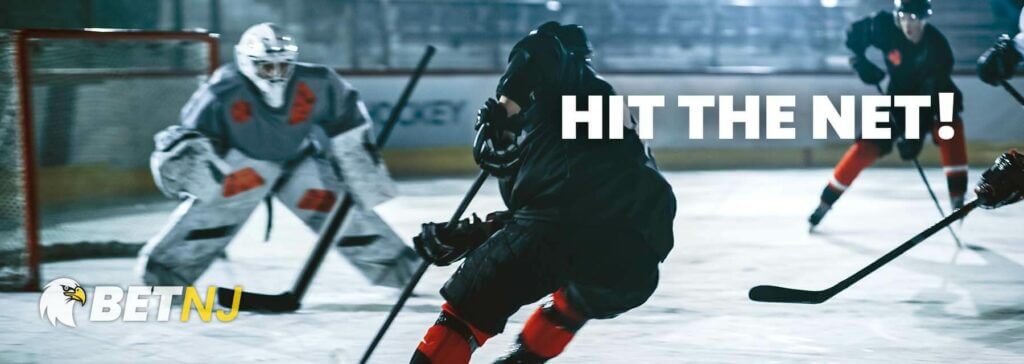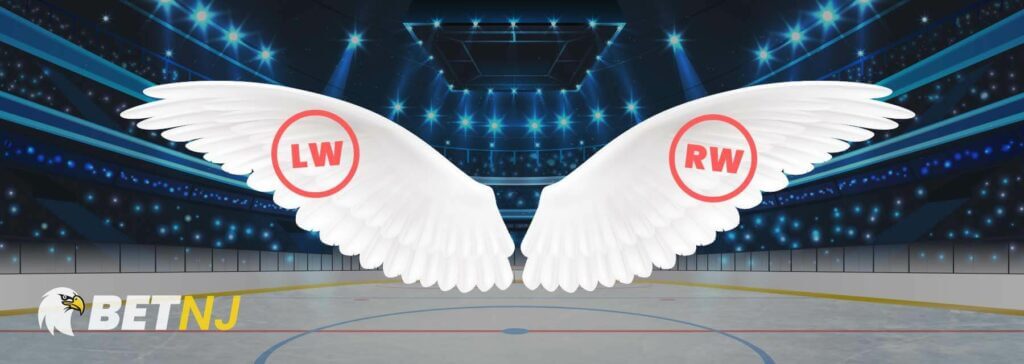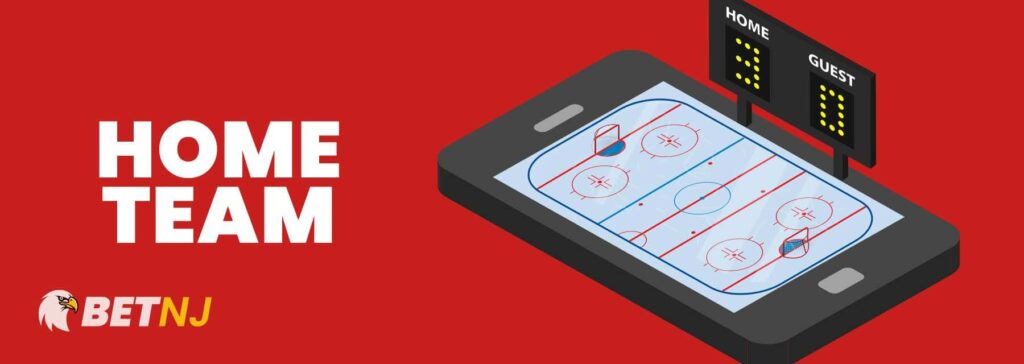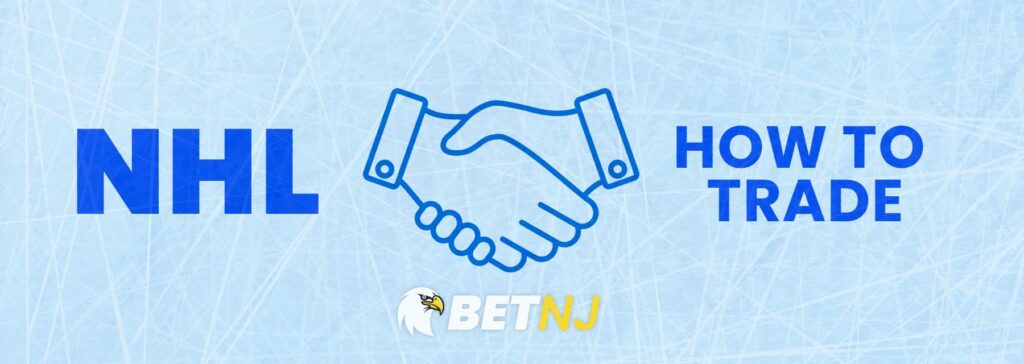Basic NHL Rules
On the ice, NHL rules state that there are six players (including the goalie) on both teams, plus two referees. Each of the players has vital responsibilities and work in sections of the rink, but more on that later.
To begin the game, the puck is dropped in the center, and the center player takes possession of the puck. The team must then work the puck down the rink without it being intercepted to then take aim and score a goal.
Game Objective
The objectives are simple. The teams must work together to move the puck from the center down to the opponent’s goal and score to receive points.

Unlike the NFL, there isn’t a number of times in which the puck can be intercepted before possession is passed over.
Hockey is similar to soccer or basketball in the fact that play is fast-paced and mostly continuous during the periods; even the pauses for face-offs are brief.
To be successful with your NJ sports betting it is vital to know all the basic rules and always compare the odds so you know how to think when choosing the best betting lines for your wagers.
NHL Rules of the Rink
According to the NHL rules, the rinks are required to be 200 feet long by 85 feet wide. They are smaller than international arenas, which makes for a more fast-paced and tactical style of play.
The ice is divided into sections where each player can fulfill his responsibilities.
There are two goals either side of the ice, surrounded by 11-foot board zones that separate the area of play from the spectators, for obvious safety reasons.
Then, there is an attack zone and defending zone ahead of the goals, which are 64 feet long. The neutral zone is 50 feet long and takes center position.
It envelopes the center circle and referee crease. There are also four face-off zones and four face-off spots indicated in red on the ice surface.
Player Roles
In total, an NHL team roster is allowed to be composed of 23 players. There are two units on an NHL team; these are forwards and defensemen.
A forward’s role is to take possession of the puck and move it down the ice to score. On the other side, the defensemen are responsible for stopping the other team from getting the puck and scoring.
There are three forward players on the ice during a game that take up different positions in the unit.
Center – Takes control of the puck drop and dictates the movements when play is in the neutral zones. Essentially the center plays both offensive and defensive.
Their responsibility is to move the puck into the offensive zone. They can move as far as the opposing teams’ face-off dots, and they are key players in winning face-offs to open up scoring opportunities for wingers.
Left and Right-Wing – This position allows the player to take control of either the left or right side of the ice from the center circle.

It is their responsibility for facing off for control of the corners, carrying the puck into the offensive zone, and blocking out the opponent’s defensemen. Wingers are essential for setting up plays for successful goals.
There are then two defensemen on the ice at one given time.
Left and Right Defenseman – These players are responsible for controlling play while the puck is in the defensive zone. They work in unison to block shots, cover open areas of the zone, and protect the goal.
Defensemen are skilled at positioning themselves at all times to create a barrier between the opposing team and a good shot.
Goalie – The goalie is the essential player on the ice. He possesses a variety of skills and is the key to stopping the opposing team from scoring.
He is so crucial that this player often has the most authoritative opinion on the team. They are positioned between the goalposts, but they can leave their section to make break out passes.
Within the units, a strong NHL roster will have a well-planned set of specialists. A specialist player will take on a particular playing style to benefit the team.
Even the goalie will master a playing style which a coach thinks best benefits the team.
These subcategory rolls are based upon a player’s skillset, physical stature, stamina, and much more. You may hear NHL players being described by their roles which include:
- Sniper
- Playmaker
- Power Forward
- Two-way Forward
- Grinder
- Enforcer
- Shutdown (Defensemen)
Scoring
An NHL goal is relatively small compared to the size of the rink. It measures 72 inches wide, 48 inches tall, and is 40 inches deep.
When the puck goes over the goal line regardless of whoever deflected it across, a single point is awarded to the opposing team who doesn’t own that goal.
Whichever team has the most goal points by the end of the regulation is the winner. This is also one of the most popular NHL betting types called the moneyline.
The Art Ross Trophy is awarded at the end of the regular season to the player with the most goals and assist points.
NHL Player and Team Rules
Hockey has a selection of NHL rules that intensify the game and regulates possession. The most important of these is undoubtedly the face-off.
As previously mentioned, there are a total of eight face-off areas, and they are essential for the flow of the game.

Any player on the ice can participate in a face-off, but the center usually takes charge. It is called when a referee or linesman decides no more passes can be made.
The whistle will then blow, and the players have five seconds to be ready at the dot where the puck will be dropped. If a player isn’t at the dot in time, the puck is dropped regardless.
The home team has an advantage over the visitors in a face-off. They can place their stick down to signal the puck to be dropped. With the home team controlling the drop, they can better anticipate the next move.
A player can be kicked out of a face-off and replaced by another for a variety of reasons. NHL Rules must be strictly followed for the team to have the best player in for the job.
Another crucial rule for players to follow is the offside rule. The offside rule stops players from positioning themselves near the goal, waiting for a teammate to feed them the puck. No skill is involved in this scenario.
Instead, the players of the attacking team must leave at least one foot on or behind the offensive zone’s blue line until the puck crosses the line.
Coach NHL Rules
Team coaches also have to abide by a set of strict NHL rules. The most important rule for them is the Challenge.
There is now no limitation to how many times a coach can challenge a play, but if it is deemed inaccurate, they will receive a penalty.
The categories that these challenges fall into include offside and interference with the goalkeeper. As recently as the 2019/20 season, a third was added. Coaches can now also challenge goal calls.
If the decision from the referee were correct after video review, the coach get a punishment in the shape of 2 minutes penalty for one player.
Time Limits and Game Duration
A game will run for a total of 60 minutes (regulation), split into three periods of 20 minutes. The clock will stop running when the puck is not in play.
NHL Overtime Rules
Overtime is “sudden death” and runs for an additional 5 minutes, and the first team to score wins. The number of players is reduced to 3 skaters and a goalie.
If no team scores during those five minutes, the best of three penalty shootouts will then begin. Whichever scores the most goals during the best of three is declared the winner.
In the Playoffs, there is not a penalty shootout format. Instead, the teams are reduced to five vs. five, and the time limit is 20 minutes. Again whoever scores first within the time is crowned victorious.
Fouls and Violations
There are many actions that are deemed violations. If a coach, team, or player violates the rules, then a penalty will incur. The penalties protect the flow, fairness, and safety of the game.
A penalty box is used for players to wait out their given time deduction. In some instances, players can be released early if the opposing team scores a certain amount of goals before the penalized team in the box is up.
Examples of some illegal acts include:
- Charging
- Delaying the clock
- High sticking
- Icing
- Fighting
- Hooking
- Tripping
- Unsportsmanlike conduct
The violations are categorized into levels of severity. Each has different penalties attached. The most seen example of these are:
Minor – Two-minute penalty for each offending player. One player, released by one goal.
Double Minor – Actions that result in blood equal four minutes in the box and released by two goals scored.
Bench Minors – Violations made by players or officials, not on the ice. Two-minute penalty.
Coincidental Penalties – Equal violations from both sides. Each team’s offending player will spend two minutes in the box.
Major – Are usually given for fighting. Offending players will be out of the game for five minutes with no early releases.
Match Penalties – Are the most severe penalties. A player will officially be sent out of play for 10 minutes for intentionally trying to injure another player.
Players can be ejected by the coach in a trade for a five-minute penalty where they will play shorthanded.
There is also misconduct, game misconduct, and penalty shots.
Equipment
All equipment must be club and league-approved, and players are expected to wear mandatory items. Mandatory equipment for players includes:
- Helmets
- Mouthguards
- Shoulder pads, elbow pads, and knee pads
- Gloves
- Cup (Jockstrap)
- Pants and team sweater
- Skates (Leather, no toe pick, rounded heel)
- Hockey stick
A goalie will have extra mandatory and necessary items to fulfill his role. You will notice they have large knee pads, a catching glove, and a blocking pad worn on the arm.
They also must wear a neck shield and chest protector.
Referee and Procedures
On an NHL rink, there are two referees and two linesmen that work together to oversee the game. The referees are responsible for enforcing the rules and keeping order.
They can be easily identified by their black and white striped long-sleeve and orange armbands.
A referee will conduct puck drops, face-offs, and call penalties. It is also their job to work with linesmen to view video, assist during challenges, and make the final decisions.
Player Trading Rules
The NHL abides by a strict trade deadline window. The window for trading takes place 40 days prior to the end of the regular season.
Any trade must be made by 3 PM on the final day for the player to be eligible to play in the playoffs in his new team jumper.

There can be restrictions in a player’s contracts to trading. One of which is the no-trade clause. If a player is aged 27 years old or they have competed in seven seasons, they can have a no-trade term added to their contract, which disallows the team from trading.
A no-movement clause is a tighter version of the no-trade. With this in a player contract, they can not be traded, waivered, re-assigned without mutual agreement.
New Changes in NHL Rules
The 2019/20 NHL season had a number of rules changes unanimously approved by the league’s governors. These rules aim to enhance the safety of players and develop the flow of the game.
One of the most significant rule changes followed in the footsteps of many other major league sports. NHL referees are now required to inspect on-ice video reviews for all major and match penalties occurrences.
Another significant change to ensure the safety of the players surrounds the loss of a helmet. If a player loses his helmet, they must exit the ice or retrieve the helmet immediately.
The only instance when play is permitted to go forward is if it was already taking immediate action against the puck or goal.